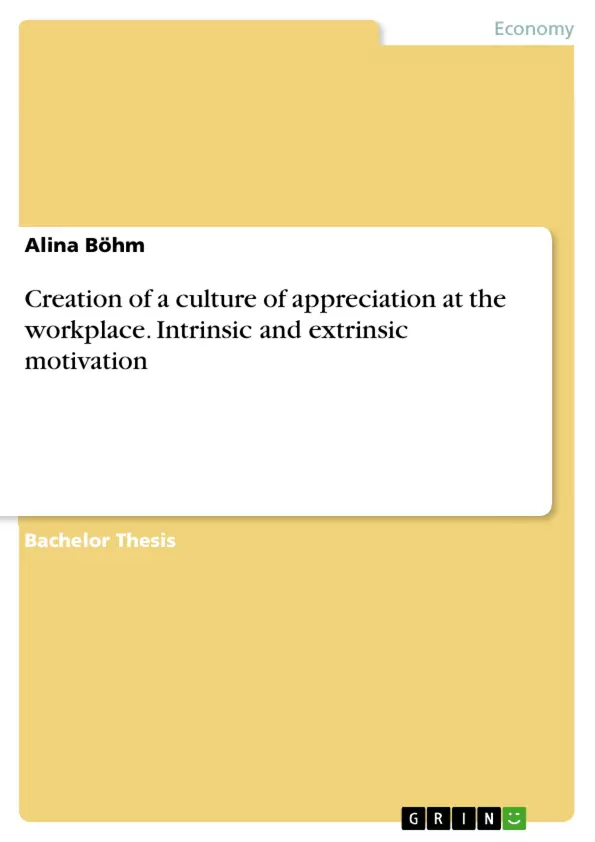This thesis is about the creation of a culture of appreciation at the workplace.
The basic needs of a human being were first addressed by the scientist Abraham Maslow, who designed a pyramid of needs. In this pyramid, he identified five hierarchical levels, which factors are essential for people to experience a satisfying feeling. At the top of the list is the need for self-fulfillment.
This need is also reflected in the world of work. Almost everyone wants to be seen and appreciated by their colleagues and managers. The topic of appreciation in the workplace is not new, but it is becoming increasingly important for companies. As the birth rate in Germany is steadily declining, there will be fewer and fewer young skilled workers on the labour market in the future. From this, the question can be derived, to what extent can employees be made to feel equally valued as a human being and as a worker? And does this appreciation have a higher value for the employee than the salary.
Inhaltsverzeichnis (Table of Contents)
- Introduction
- Problem definition
- Objective of the thesis and structure
- Basics
- Definition of the term appreciation
- Motivation
- Intrinsic and extrinsic motivation
- Motivational tools
- Financial incentives
- Appreciation as part of corporate culture
- Definition and models of corporate culture
- Characteristics of an appreciative corporate culture
- Characteristics of a successful corporate culture
- Definition communication
- Schulz von Thun´s communication model
- Leadership as a motivational tool
- Mc Gregor's X-Y theory
- Appreciative leadership
- Trust
- Clarity
- Effective Communication
- The expression of praise
- Communication models
- Non-violent communication
- The Grow Model
- Feedback
- Empirical study
- Creation of a culture of appreciation using the example of Zalando
- Company profile
- Corporate culture
- 360 degree Feedback (Zonar)
- zBeat
- Online employee reviews about the company Zalando
Zielsetzung und Themenschwerpunkte (Objectives and Key Themes)
This thesis explores the creation of a culture of appreciation in the workplace. It examines the concept of appreciation, its connection to motivation and corporate culture, and the role of leadership in fostering an appreciative environment. The research investigates different models of communication and leadership, drawing upon existing theories to understand how to effectively cultivate a culture of appreciation. The study utilizes a specific company example, Zalando, to provide a practical demonstration of the principles discussed.
- Definition and significance of appreciation in the workplace
- The relationship between appreciation, motivation, and corporate culture
- Leadership styles and communication models that support a culture of appreciation
- Empirical research methods and data analysis to explore appreciation in a real-world context
- Applying the findings to a specific case study: Zalando
Zusammenfassung der Kapitel (Chapter Summaries)
The introduction defines the problem of creating a culture of appreciation in the workplace and outlines the objective and structure of the thesis. Chapter 2 examines the concept of appreciation, providing a definition and exploring its connection to motivation. This chapter investigates various motivational factors, including intrinsic and extrinsic motivation, motivational tools, and financial incentives. Chapter 3 delves into the role of appreciation within corporate culture, discussing different models and characteristics of a successful corporate culture. This chapter also explores communication within the context of an appreciative workplace, including Schulz von Thun´s communication model. Chapter 4 focuses on leadership as a key driver of an appreciative culture. It examines the effectiveness of different leadership styles, including McGregor’s X-Y theory and appreciative leadership, and explores the importance of communication, trust, clarity, and praise within an appreciative leadership approach. This chapter also discusses different communication models, including non-violent communication, the Grow Model, and feedback. Chapter 5 presents the empirical study, outlining the chosen research methods, presentation of results, and evaluation of findings. This chapter utilizes data analysis to provide insights into appreciation within the workplace. Chapter 6 applies the findings to the case study of Zalando, exploring the company’s profile, corporate culture, and implementation of initiatives to promote appreciation. The chapter examines the effectiveness of Zalando’s approach and analyzes the impact of their efforts on employee engagement and satisfaction.
Schlüsselwörter (Keywords)
The key concepts of this thesis include appreciation, motivation, corporate culture, leadership, communication, empirical research, case study, and Zalando. The study focuses on understanding the relationship between these factors and how they contribute to the creation of a positive and productive work environment. Key themes explored include the impact of appreciation on employee morale, engagement, and performance, as well as the role of leadership in shaping an appreciative organizational culture.
- Arbeit zitieren
- Alina Böhm (Autor:in), 2021, Creation of a culture of appreciation at the workplace. Intrinsic and extrinsic motivation, München, GRIN Verlag, https://www.grin.com/document/1172101



